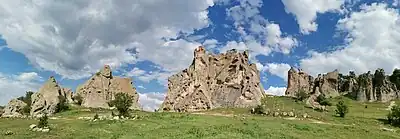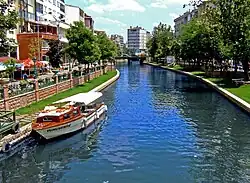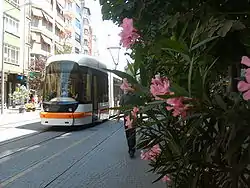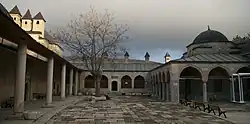Eskişehir is a city in the northwestern part of Central Anatolia. It is often known nationwide as the "students' city" because of the large numbers of students enrolling three local universities who make up at least a tenth of its 885,000 residents (2019).
Seldom on the travellers' itineraries in the past, Eskişehir is now quickly polishing its historic attractions, and investing a lot on city beautification projects in the hopes of marketing itself to a wider audience. Now with the high speed rail link in place, the regional tourists, at the very least, are quickly responding in consideration of checking out the "miracle in the steppes" — the "Venice of Anatolia", as they say, rather hyperbolically. Home of the hippest crowd in a largely conservative inland Turkey, Eskişehir is great for a laid-back day or two to break your Turkish odyssey, also providing a convenient base to explore the little visited surrounding region.
Understand

The area is inhabited since before the Phrygians founded Doryleaum near present-day Eskişehir (pronounced es-KEE-sheh-heer), the name of which translates to "the old city" in Turkish — a fitting name as the city fully embraces modern life while still maintaining a sense of tradition and ancient values. The area to the south of Eskişehir is known as the "Phrygian Valley" even today and contains many monuments from the Phrygians (some parts of the valley is within the borders of neighbouring Kütahya and Afyonkarahisar provinces).
Eskişehir is a haven of liberalism in a largely conservative region, which stems from the large student population as well as the already-progressive-minded culture of the refugees from Crimea and the Balkans settled in the city in the late 19th century during the decline of the Ottoman Empire. Their descendants constitute most of the native population, who are well-adapted to the ideals of a westernized nation of the Republic.
One of the few cities in Turkey with more than one state university, Eskişehir is home to Anadolu University, Eskişehir Technical University and Eskişehir Osmangazi University, all amongst the biggest universities of the country.
Despite its name, most of the city is new construction, with the oldest buildings being no more than 50 years old, with the prominent exception of the neighbourhood of Odunpazarı. Since 1999, when Yılmaz Büyükerşen, the former president of Anadolu University, has been elected mayor, the city has been working hard to give its visitors a faux Central European feel with its bridges, parks, statues, and trams.
The Porsuk River bisects the city all along. The other, non-natural feature that long bisected the city, the main Istanbul–Ankara railway, now runs underground for most of its route through the city limits.
Orientation

Eskişehir is a city with two distinct yet related centres:
The youth life is centred along the riverside promenade area, Adalar, literally "the islands". Despite the name the area is a part of the mainland, except for a small river island on which the historic building of Tepebaşı City Council stands. The pedestrianized Doktorlar Caddesi (officially İsmet İnönü Caddesi), just north of Adalar, has a tram line in the middle. Doktorlar Caddesi extends towards northwest, and, past Espark shopping mall, connects to Üniversite Caddesi, which leads to the Yunusemre Campus of Anadolu University. This marks the northwestern extent of student territory.
Southeast from Adalar is Hamamyolu, another pedestrianized street with a large leafy strip in the middle—or a linear park, you might say. This is the older city centre and where locals and families rather to hang out and go shopping. At the southeastern end of Hamamyolu is Odunpazarı, the Ottoman district.
Adalar and Hamamyolu meet at Köprübaşı ("the bridgehead"), marked by the bridge on which the tram line crosses Porsuk.
Tourism information office – Vilayet Sq 1, tel +90 222 230 38 65
Climate
The climate is semi-arid and continental; summers are hot and dry, winters are cold and snowy, transitional seasons are cool to mild, albeit with a short storm season in spring.
Get in
By plane
Fly to Istanbul Sabiha Gökçen airport (SAW IATA), take taxi or bus 10 km to Pendik station, then YHT train (as below) to Eskişehir. YHT connections are also possible from Ankara or Konya airports.
By train
Eskişehir is near the junction of Turkey’s high speed railway system (YHT), with frequent fast trains to Istanbul, Ankara, Konya and Karaman. The 🌍 railway station is in the modern part of town, some 5 km north of the old quarter. Trams connect to the centre.
From Istanbul to Eskişehir there are 11 daytime trains, taking 3 hours, mostly continuing to Ankara. From Ankara to Eskişehir there are 13 daytime trains, taking 90 min. To Konya there are three trains a day taking 90 min; one continues to Karaman. Change in Konya for buses to Antalya, and connections to Adana.
An overnight train between Istanbul and Ankara calls at Eskişehir at around 01:00 westbound and 04:00 eastbound. There is also an overnight sleeper taking 11 hours to Izmir Basmane station and a daily train takes 6 hours to Denizli, for Pamukkale (formerly as a sleeper, but now a day train). Buses to Bursa (2¼ hours) connect at Eskişehir with the YHT trains.
By car
The city is 335 km away from Istanbul, 228 km from Ankara, and 144 km from Bursa.
Eskişehir lies on the highway D200/E90, which connects Bursa, a major city in the northwest, with Ankara, the national capital. From Istanbul, take D100, O-4/E80 (toll) or O-7 (toll) eastwards to Adapazarı to branch off into the southwards D650 there. In Bozüyük, hit D200/E90 to the east. The route from Istanbul is up to motorway standards with divided directions all along, although a tunnel or two through the Sakarya valley might be under maintenance works, as was the case in summer 2021, resulting in temporary single carriageways in short sections.
By bus
Usually about 60+ TL, (sept 2022) per person if you're coming from Ankara, the bus rides to Eskişehir reveal a beautiful view. From the city of Burdur in the south the price is 25 TL, from Antalya 35 TL.
By boat
An alternative route from Istanbul is to take the Budo ferry from Kadikoy to Mudanya (6 per day, 1 hr 50 min) then bus, taxi and metro to Bursa Otogar (allow an hour) then bus to Eskişehir.
Get around

The city has a tram network, that as of 2021 exceeds 50 km (30 mi) in length and connects with the far-flung suburbs. Line #1 is perhaps the most useful to the traveller: among others, it stops at or in close proximity to the bus station (stop: Otogar), the old town/Odunpazarı (Atatürk Lisesi), the modern centre/Köprübaşı (Çarşı), Doktorlar Caddesi (İsmet İnönü), the train station (Espark), and the Yunus Emre campus (Anadolu Üniversitesi).
Minibuses and public buses cover the rest of the city. The city also has a small fleet of 19th century-looking horse-drawn carriages, and a large taxi fleet. At almost anywhere on the large streets, you’ll see buttons (looking like electric switches) hanging on walls, trees, etc. To call a cab, you need only to push one of those and the nearest taxi stop will soon send a taxi to where you have pushed it. But walking is probably the best way of transportation in this largely flat city, it is free of charge and the distances aren’t that huge.
See
Odunpazarı
.jpg.webp)
Colourfully renovated Ottoman houses stand in rows along the cobbled streets of Odunpazarı, the old town, 2 km (1.2 mi) south of the modern centre.
- 🌍 Alaaddin Mosque (Alaaddin Camii).
- 🌍 Caricature Museum (Karikatür Müzesi).
- 🌍 Kurşunlu Mosque (Kurşunlu Camii).
- 🌍 Meerschaum Museum (Lületaşı Müzesi). Dedicated to meerschaum (German for "sea foam"), known by geologists as sepiolite, a white clay material that is so soft before exposure to sun that it can be carved into great figures and shapes. The primary deposits of meerschaum in the world are in Eskişehir Province.
- 🌍 Museum of Independence (Kurtuluş Müzesi).
- 🌍 Museum of Modern Glass Art (Çağdaş Cam Sanatları Müzesi).
- Museum of the Republic (Cumhuriyet Tarihi Müzesi).
- 🌍 Museum of Woodworking (Ahşap Eserler Müzesi).
- 🌍 Odunpazarı Modern Museum (Odunpazarı Modern Müze). A modern art museum in a throughly modern building built of sustainably harvested wood.
- 🌍 Typewriter Museum (Daktilo Müzesi).
- 🌍 Yılmaz Büyükerşen Wax Museum (Yılmaz Büyükerşen Balmumu Heykeller Müzesi).
Elsewhere
- 🌍 Aviation Park (Havacılık Parkı). An open air military museum.
- 🌍 Eti Archaeology Museum (Eti Arkeoloji Müzesi), Atatürk Blv.
- 🌍 Karacahisar (10 km southwest of the centre). The scrappy ruins of a hilltop Byzantine fortress, which was the first to be grabbed by the Ottomans (in 1288), then a semi-nomadic tribe in nearby Söğüt. The village mosque nearby takes pride in being the site of proclamation of the Ottoman sovereignty for the first time.
- 🌍 Kentpark (3 km east of the centre, just south of the bus station). A park straddling both banks of the Porsuk River, which are artificially covered with sand and put to use as a public beach.
- 🌍 Sazova Park (Sazova Parkı) (5 km southwest of the downtown). With a zoo, an aquarium, a miniature railway, scale models of landmarks from around the Turkic-speaking countries, a pond complete with its "pirate ship", and a Disney-like castle (combining elements from actual structures across Turkey), kids will be particularly entertained here.
- 🌍 Türasaş Museum (formerly known as Tülomsaş) (just southwest of the train station; follow the river for 1.5 km west from the centre). Dedicated to transport technology history. One of the masterpieces is a prototype of Devrim, the first ever Turkish manufactured car (1961), that was never put into mass production.
Do
Eskişehir is known for its hamams (Turkish bath), although there seems to be no particular reason for this fame. There are some baths in the city centre, dating back to Ottoman period. Upon entrance you’ll be asked to put off your shoes and wear the slippers provided. Then you’ll put off all your clothes and wrap yourself in one of the large towels provided. A locker for clothes is provided. Have a through shower and wash your hair before entering the marble hot tub area. Don’t let soapy water leak into the communal pool, if you’ll also have a soapy scrub next to it. Staying more than one hour in the hot section is not advised (especially for the first time) as the very hot air and steam inside can cause the blood pressure to rise considerably. Once you’re done in the hot tub, you’ll be wrapped in the dry room all over your body and head, and asked what drink you’d like. Although never that pricey, the fee of this drink isn’t included in entrance fee, and you don’t have to drink anything if you don’t want to. Usually having a lemon soda is recommended, though, as it’s thought to lower the blood pressure back to normal level.
Entrance is about 5 TL/person, massage costs a further 5 or 10 TL (of course it’s not compulsory to have a massage and pay another fee just because you entered the bath if you don’t want to), towels are provided for free, shampoo and soap are provided for 0.50 or 1 TL each. The price is not hourly, i.e. you can stay inside as long as you like (remember the ‘no-more-than-one-hour-for-the-first-time’ rule, though).
Women and men have separate sections (and enter the building from separate gates).
- Hot springs (kaplıca) also abound in the surrounding region.
- Eskisehir Sazova Park of science, culture and art
- Kentpark (City Park)
- Love Island
Learn
Anadolu University participates in pan-European university student exchange programs.
Buy
As you would expect from a big city, there are many ATMs around and credit cards are accepted in most places.
- Meerschaum souvenirs – often in the form of high-quality tobacco pipes.
- 🌍 Atlıhan (Odunpazarı). The tastefully renovated caravanserai with an open courtyard now houses handicraft shops, great for souvenir hunting.
Eat

Because of the relatively large university student population, the streets near the Porsuk downtown are teeming with local and American-style fast food restaurants and pizzerias.
Local food include:
- Çi börek (or sometimes also spelled çiğ börek) — a Crimean Tatar delicacy that can be commonly had in the city as a lunch. It's a deep fried pastry of thin, half moon-shaped dough filled with minced meat and onion lightly sprinkled with black pepper. The traditional Tatar way of having it is by hand (perhaps with a napkin), so they don't provide forks in their eateries.
- Kırım Çibörek, Atalar Street and in Kentpark. They are Crimean Tatar.
- Çibörek evi, Eastern end of Atatürk Boulevard.
- Papağan Çibörek, Has two locations, both near Köprübaşı.
Budget
- Donas is a wrap of chicken meat, potatoes, and a dash of vegetables, all abundantly poured over with sauce. It's sticky, tasty, hearty, and cheap.
Mid-range
Splurge
Drink
Since it is a usual habit for university students to binge drink and to pub crawl, there are many bars, pubs, clubs, and discos scattered around the city. It is usually possible to attain a live music performance at weekends.
- Haller Gençlik Merkezi – Once warehouse of the city for fresh groceries, this elegant building has been renovated and now houses beer-, and winehouses. It is located near the central station.
Several pubs in the riverbank of porsuk and the clubs near train station offers a good night, and also an opportunity to know local students. Some pubs by genres:
- 645 (near the riverbank, "Adalar"). Offers live hard-rock and alternative after 23:00.
- Cagdas Bira Evi. Ordinary pub! They have cheap beer, anyway.
- Travelers. A traveller cafe.
Sleep
Budget
- 🌍 Paşa Konağı butik otel, Dede, Kalender Sk. No:5, ☏ +90 222 220 23 56. Nice breakfast in the morning. 167 TL.
- 🌍 Dudes Rooms Eskisehir, Cumhuriye, Yıldırımer Sk. No:27, ☏ +90 535 399 98 56. Hostel in someone's house, but has a piano and book collection. Sometimes some live music. 136 TL.
- 🌍 Arasta Konak Butik Otel, Orta, Paşaoğlu Sk. No:8, ☏ +90 222 244 07 07. Very boutique-like, with a breakfast and dining area. 182 TL.
Mid-range
- 🌍 Capella Otel, Yenibağlar Mah, Hacı Hüsnü Sk. No:64, ☏ +90 222 320 80 80. Features a restaurant and breakfast buffet (extra charge) and some rooms with balconies, plus a sauna and small fitness center. 265 TL.
Splurge
- Ramada Plaza, Hoşnudiye Mh, 738. Sk No:7, ☏ +90 222 235 1111.
- The Merlot Hotel, Hoşnudiye Mh, 738. Sk, No:2, ☏ +90 222 310 0000.
- Hilton Garden Inn, Hoşnudiye Mh, 734. Sk No:8, ☏ +90 222 217 8888.
Connect
The city and surrounds have 4G from all Turkish carriers. As of Dec 2020, 5G has not reached this area.
Stay safe
Cope
City’s large university student population makes it a place quite easy to communicate in English, although local older generations may only speak Turkish. Also you may encounter youngsters with an ability to speak less widespread European languages such as German or French, though this is much less possible compared with English.
Nearby

- 🌍 Seyitgazi (Seyit Battal Gazi Külliyesi) (40 km south of Eskişehir). A medieval, Seljuk-built complex dedicated to Battal Gazi, a Turkish folk hero, purpotedly born in Battalgazi at the other end of the country but likely fictional, whose attributed legends became intertwined with the real-life exploits of an 8th century Islamic warrior. The complex is on a bluff overlooking the town and was later extended by the Ottomans, comprising a mosque, a madrasa, a dervish lodge, and a caravanserai, which once served the pilgrims on the Hajj to Arabia.
- 🌍 Yazılıkaya (not to be confused with the Hittite site of the same name near Çorum) (70 km south of Eskişehir). An impressive rock-cut relief, long thought to be a monument to King Midas who had 'the Golden Touch'. Later, it was found out to be a site sacred to the followers of the Phrygian mother goddess, Cybele, whose cult was later exported by the Romans to as far as Mauritania and Spain in the west and Afghanistan in the east. The site marks the northern point of entry into the Phrygian Valley.
Go next
- Kütahya — about an hour away to the southwest by several daily buses and trains from Eskişehir, Kütahya is a city known for its faience tradition. It also serves as a jumping off point to Aizanoi with the Temple of Zeus, one of the best preserved Roman sites in the region.
- Söğüt — the supposedly unremarkable town in the northwest is where the Ottomans emerged.
| Routes through Eskişehir |
| Bursa ← İnegöl ← Bozüyük ( |
W |
→ Sivrihisar → Ankara |
| Edremit ← Kütahya ← | W |
→ Ends at |
| Istanbul ← Arifiye (Adapazarı) ← | W |
→ Junction S → Polatlı → Ankara |
![]()